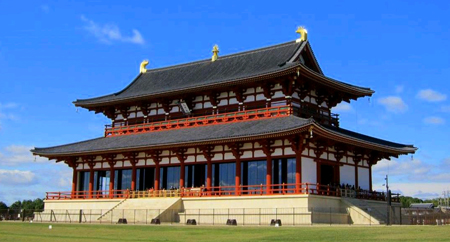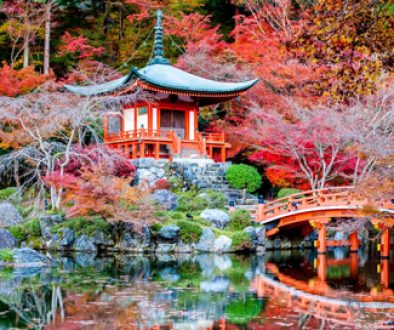Nara
The Nara period (奈良時代) covers the years from approximately 710 AD to 794 AD. Heijo Kyo served as the main imperial capital in the Nara region from 710 to 784 and was established by Empress Gemmei. It remained the capital until Emperor Kammu decided to establish a new capital called Nagaoka Kyo in 784.

The Japanese society was still at this time made up of agriculturally centric villages, and most of them still followed a religion based mainly around the worshipping of kami, which was natural and ancestral spirits.

The Nara capital was modeled after Chang’an, which was the capital city of Tang China. The influence of China continued into this period from the influence during the Asuka period. It was during this period that Japan began to adopt Chinese written characters which it named Kanji.
Literature and history began to play an important role as the oldest chronicle of Japan called the Kojiki (古事記) which could be translated as “An Account of Ancient Matters” was created between 711-712. It was a collection of myths that displayed the origin of the four main home islands of Japan. The Nihon Shoki (日本書紀) was also published in 720, and this was an expansion on the original book, translating as “The Chronicles of Japan”.
This period saw a continued rise of the Fujiwara clan, which had first formed in the early 7th century. They were involved in many parts of the country’s administration. The expansion of Japanese territory resulted in the incorporation of the southern area Kyushu into the main Japanese state. This land was then divided up into 61 provinces, including Hitachi and Yamato.
Rise In Population
There was an approximate population in the region of 5 million, and most of them lived in primitive pit dwellings, as their lifestyle was centered around agriculture and farming. The capital city of Heijo in contrast was a sphere of elite culture with a heavy Chinese influence.
Administrative affairs of the provinces, which had previously been the duty of local clans were now starting to become a full-time delegation with provincial governors being assigned to each region from the capital, and a large imperial bureaucracy being assigned to manage these affairs.
The roots of Kyoto, which would become known as the first capital city from 794 began to take a foothold, and new laws began to be introduced, following the concept of obedience and loyalty to the imperial family, which would strengthen their stronghold. This resulted in the need for a better-equipped army, something that had played very little importance up to this point, but it was this requirement that led to the development of higher quality swords, which would be the foundation of the high precision engineered swords of the samurai.
The current military service was made up of a conscript army, which had been adopted from Chinese influence too, and would include roughly 1/3rd of men aged between 21 and 60 years. This was abandoned in 792, due to it being deemed as ineffective compared to the system of hiring local warriors and would provide the model for the soon to be established samurai class.
Nara Period Gardens & Gardens of the Four Seasons
Nara Period Gardens and Gardens of the Four Seasons are two gardens in Japan that show how different cultures create their own landscape.
Introduction: Nara Period Gardens and Gardens of the Four Seasons are both located in Japan. They both have a unique cultural history and reflect the culture of the country beautifully.
Famous Tourist Attractions in Nara Japan
Nara is a city in the Kansai region of Japan, the capital of Nara Prefecture. It became a UNESCO World Heritage Site in 1998.
Nara is also famous for its historical significance to Buddhism, as well as being the site of many historically significant places related to Buddha and Buddhist beliefs. Nara is home to over 120 Buddhist temples which are some of the most interesting tourist attractions in Nara Japan.

An Introduction to the Naruhodo Experience at Japan’s Nara Park
The Naruhodo experience is a one-of-a-kind cultural experience in Nara Park. It is a joint venture between the city of Nara and the foreign tourist bureau. The program has been created to provide tourists with an authentic cultural experience of Japan.
The Naruhodo Experience offers a diverse selection of activities that take place within the walls of Nara Park. The cultural activities include:

1) Hanami: an opportunity to enjoy flower viewing under the cherry trees in the spring, or ume plum blossoms in the fall
2) Calligraphy: an introduction to Japanese Calligraphy and its history
3) Tea Ceremony: learn about Japanese tea ceremony from a professional practitioner, and have a chance to try it out yourself
Nara Period Japanese Culture & Tradition
The tenth-century in Japan was called the Nara period. This period is well-known for the establishment of the first permanent capital of Japan, Nara, and its cultural and political achievements.
For example, Japanese scripts were created during this period. The scripts were still in use until about 1100 CE. The Japanese culture that we know today was created during the Nara period.
The Legend of Nanae and Mononobe no Okoshi
The legend of Mononobe no Okoshi tells the story of how he and his wife, the goddess Nanae, saved Japan from a great flood. The story is frequently used to reinforce the importance of cleanliness to Japanese people.
Nana’s cleanliness was so great that she could scrub away anything with just her fingernails. This included both dirt and disease.
